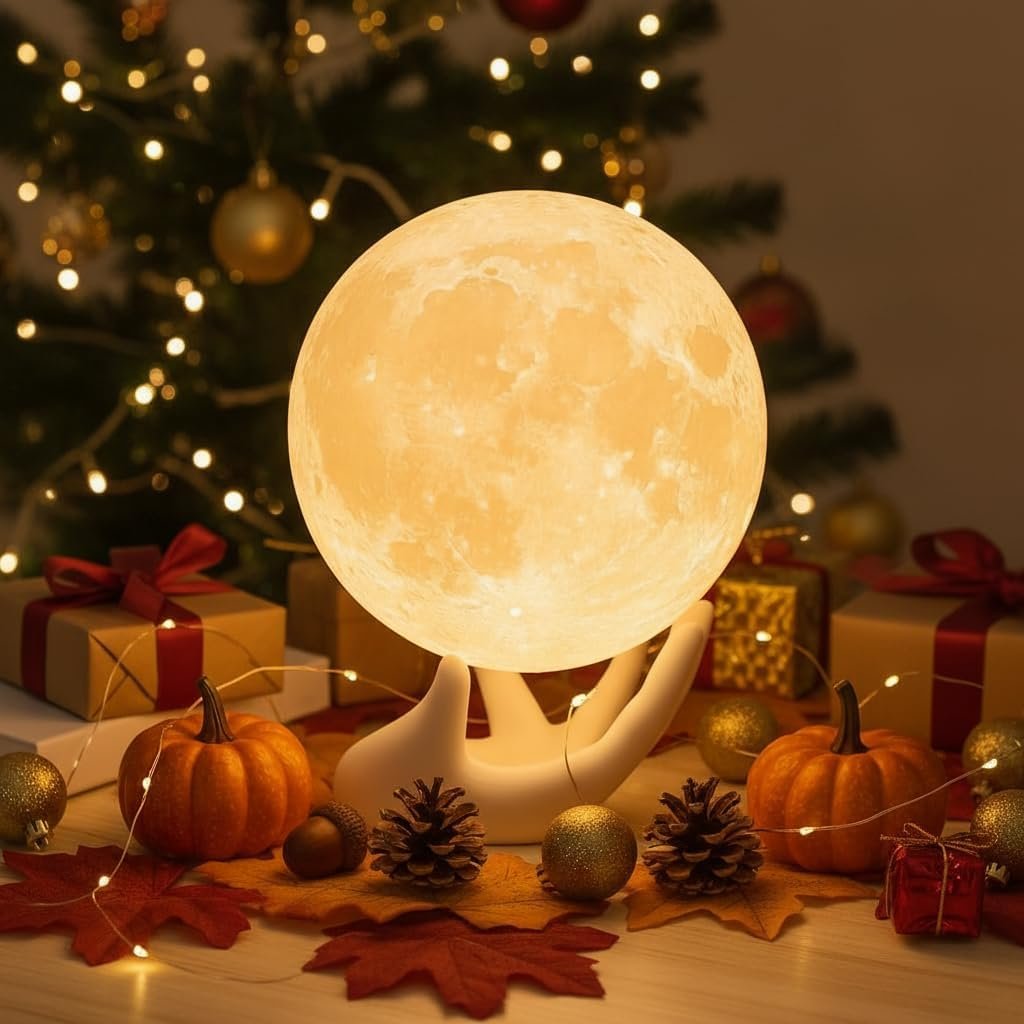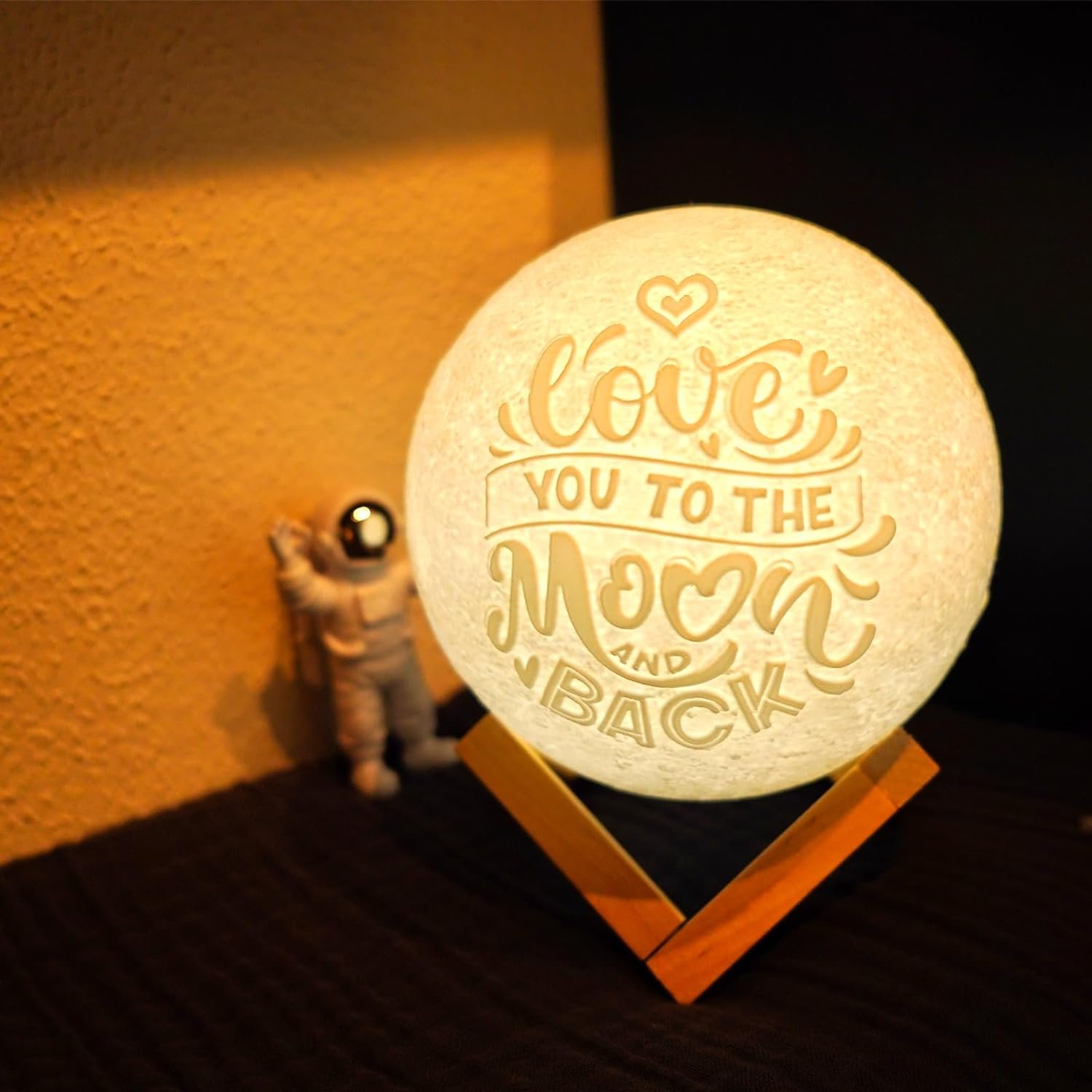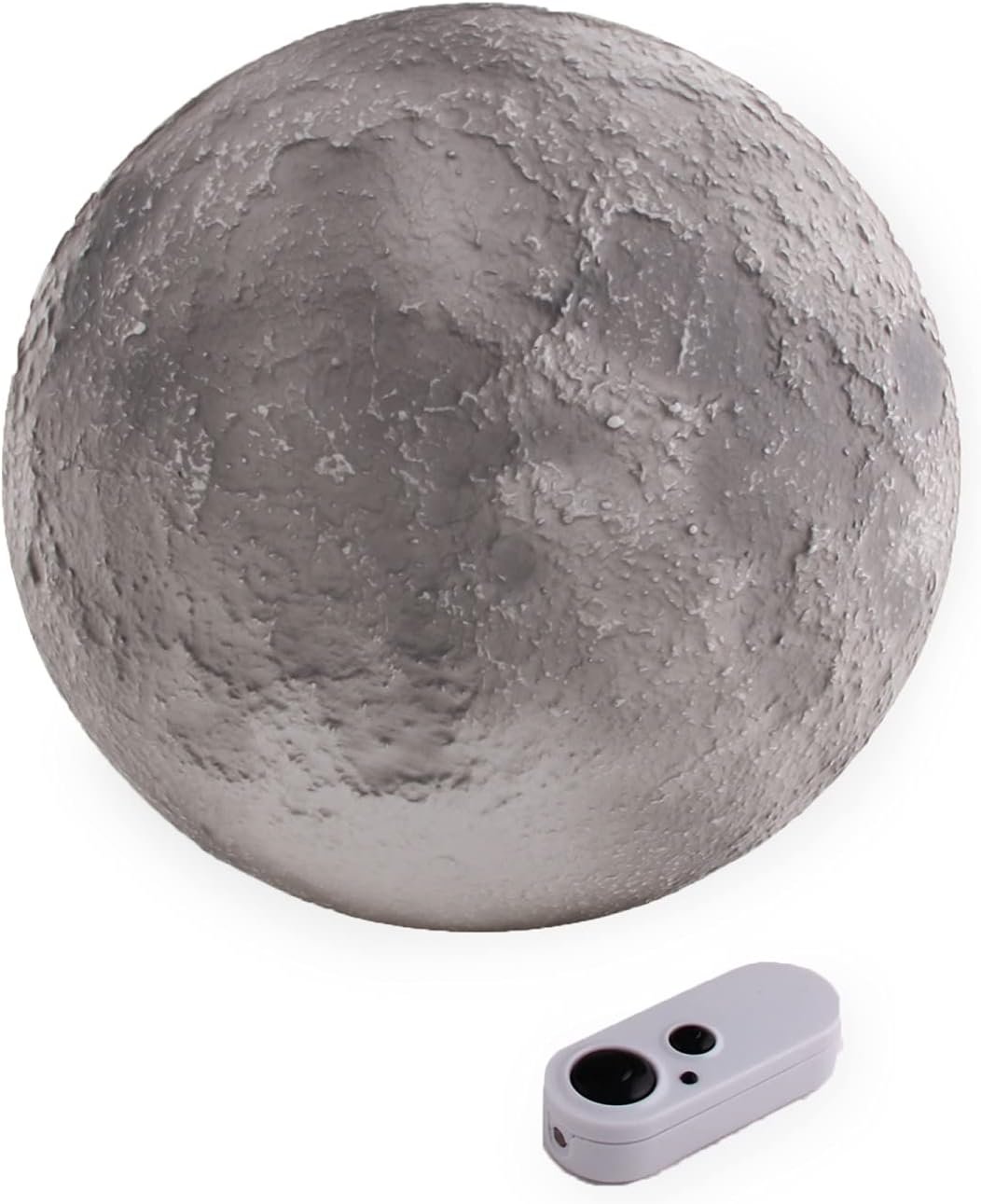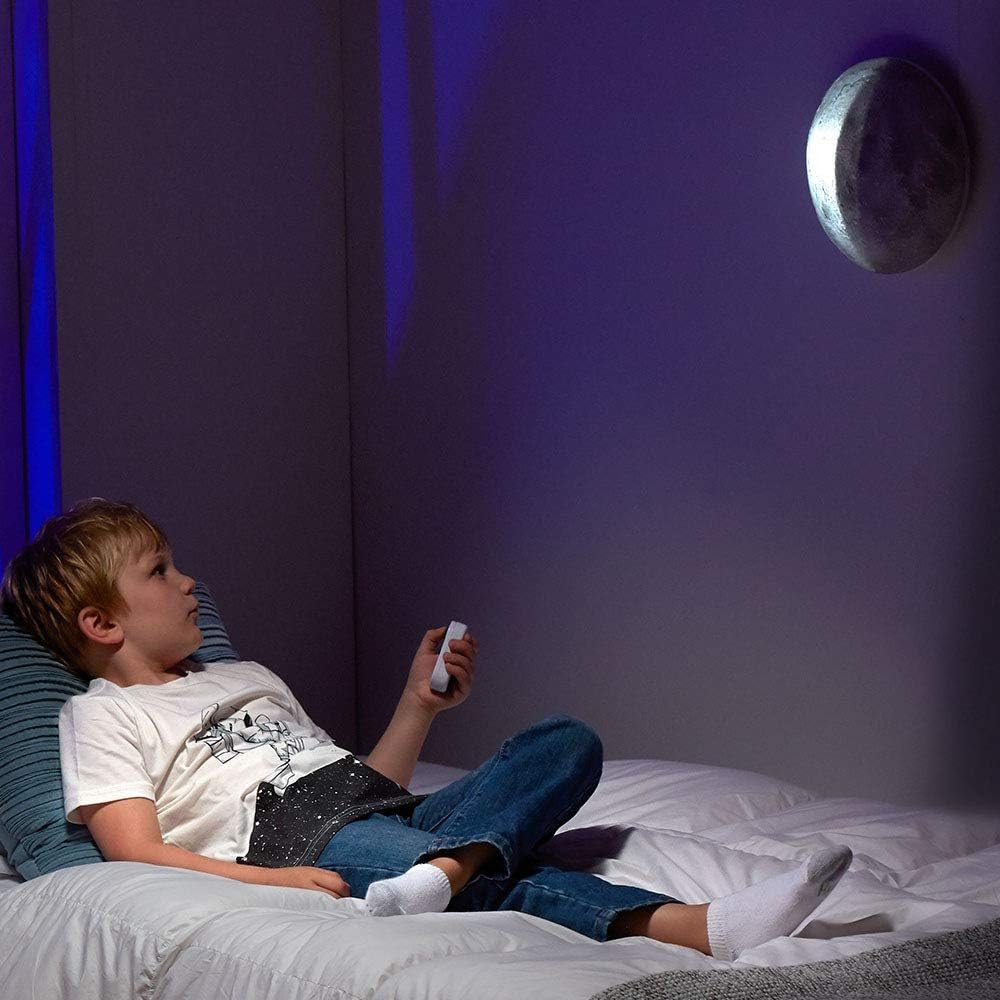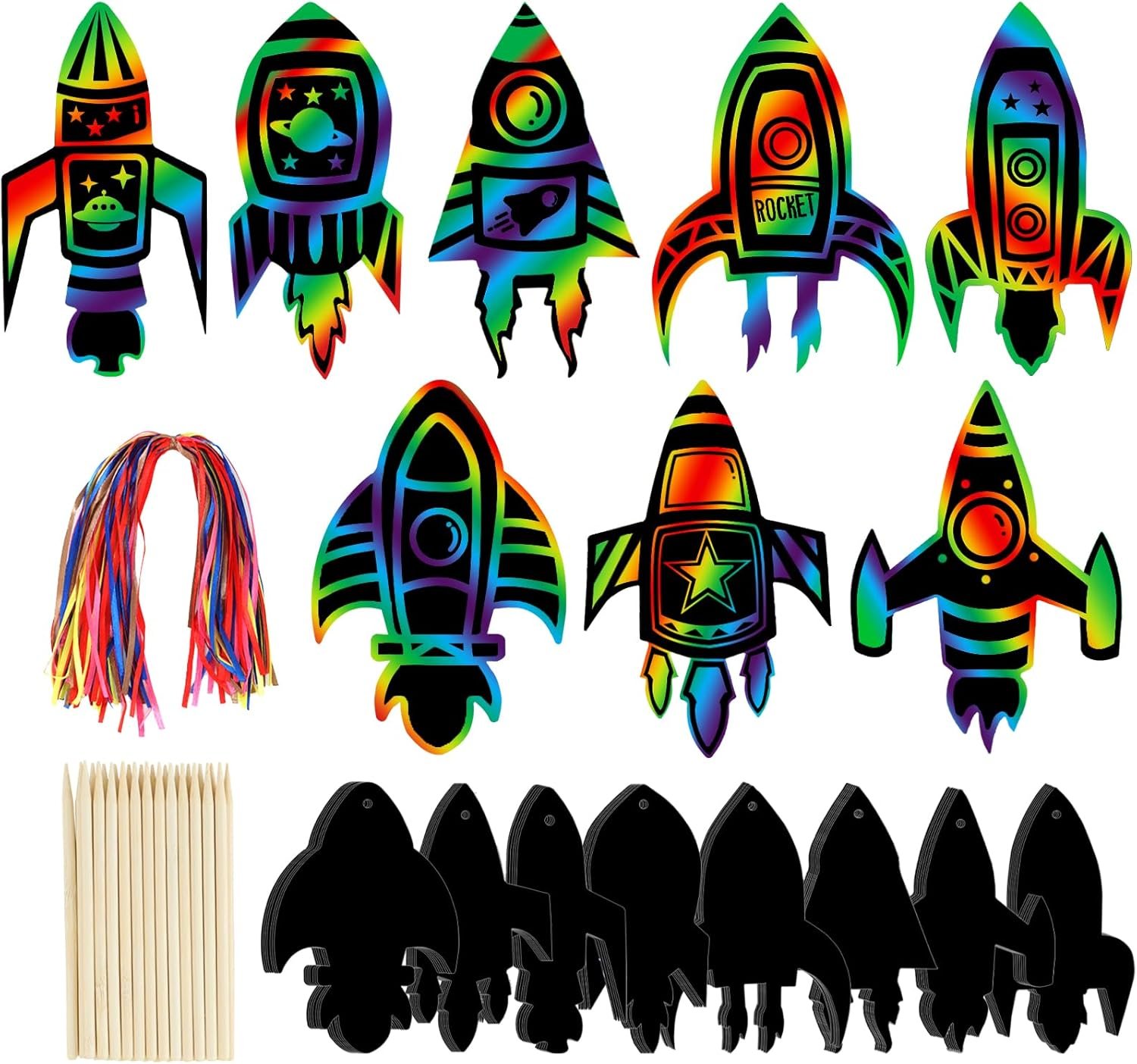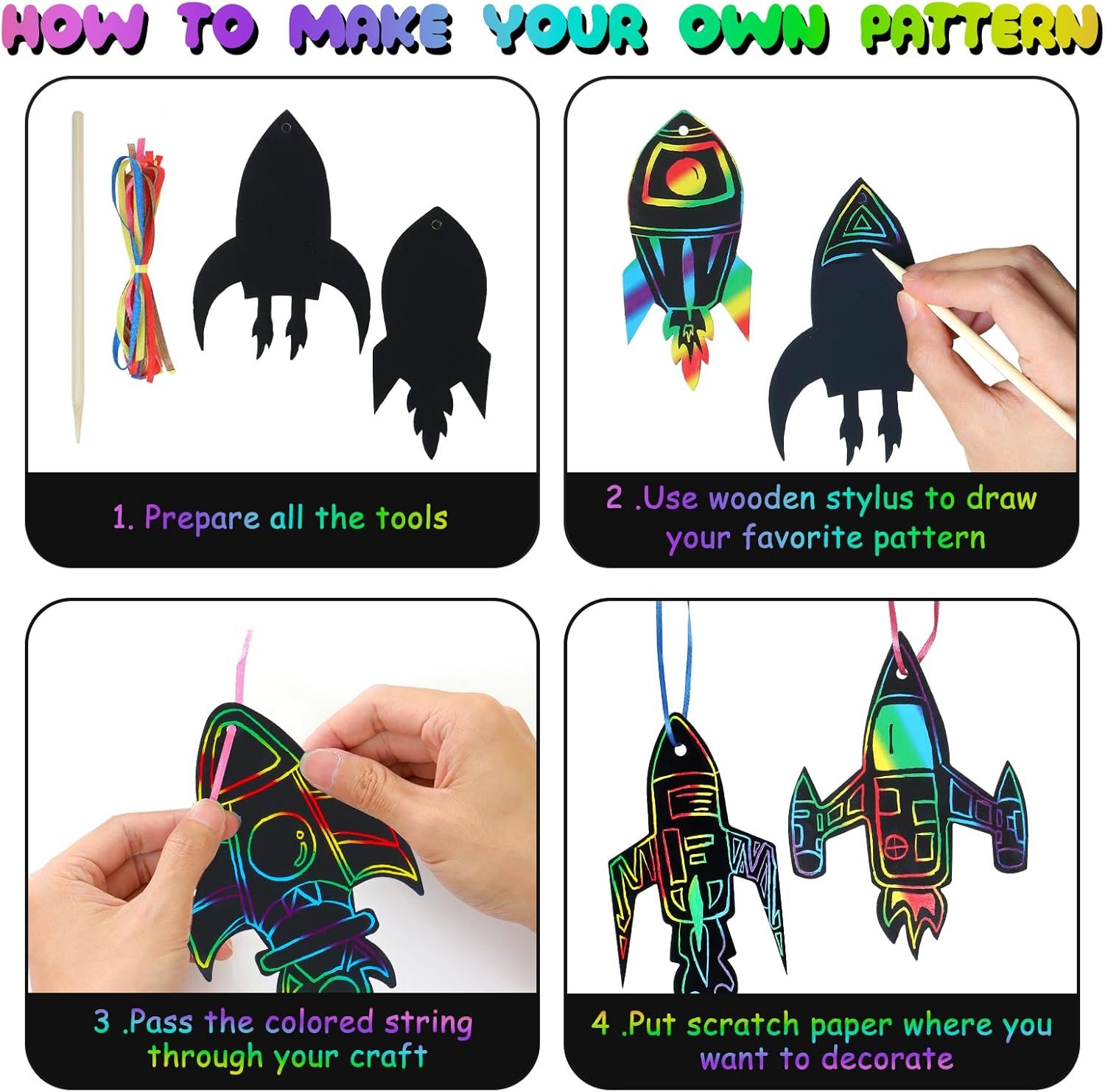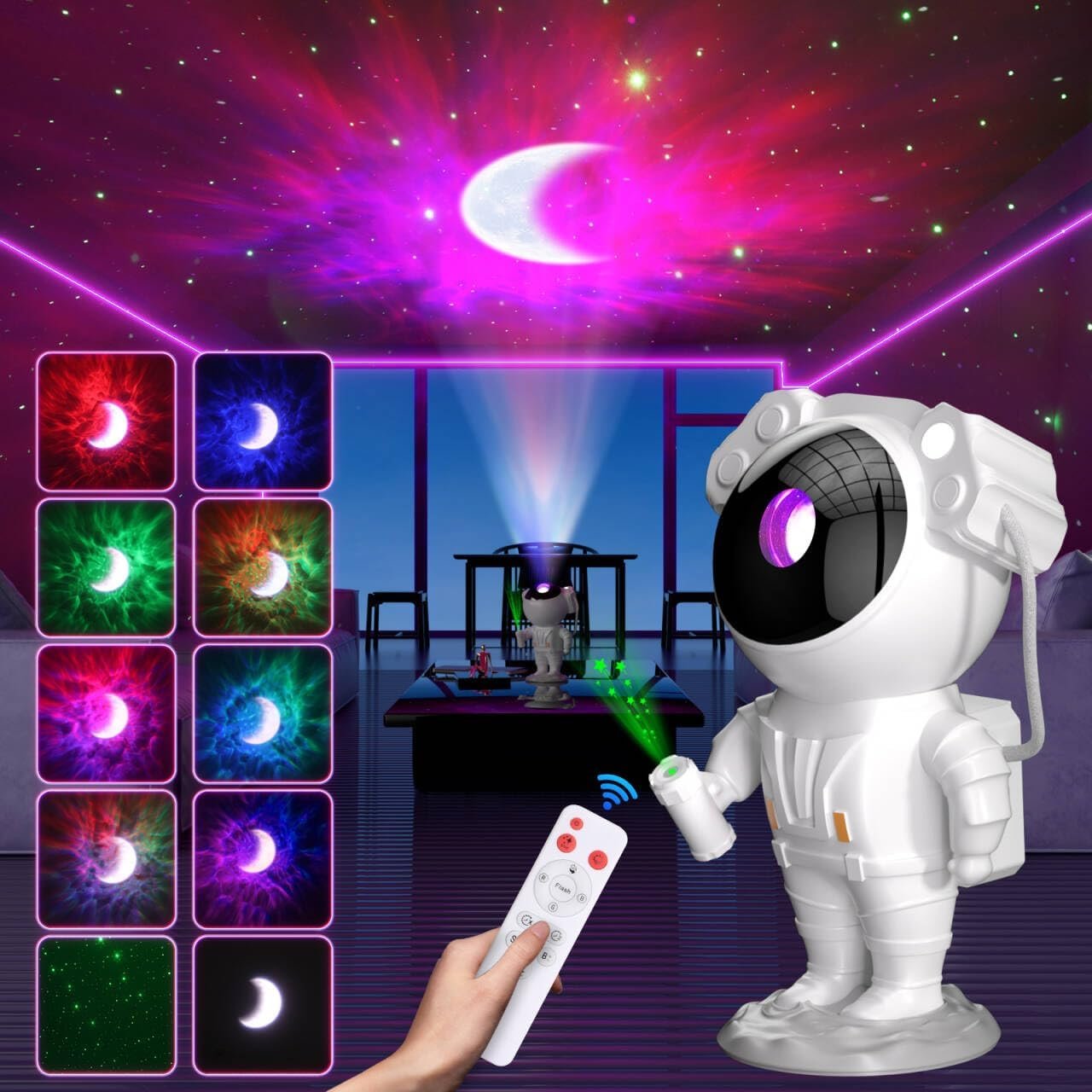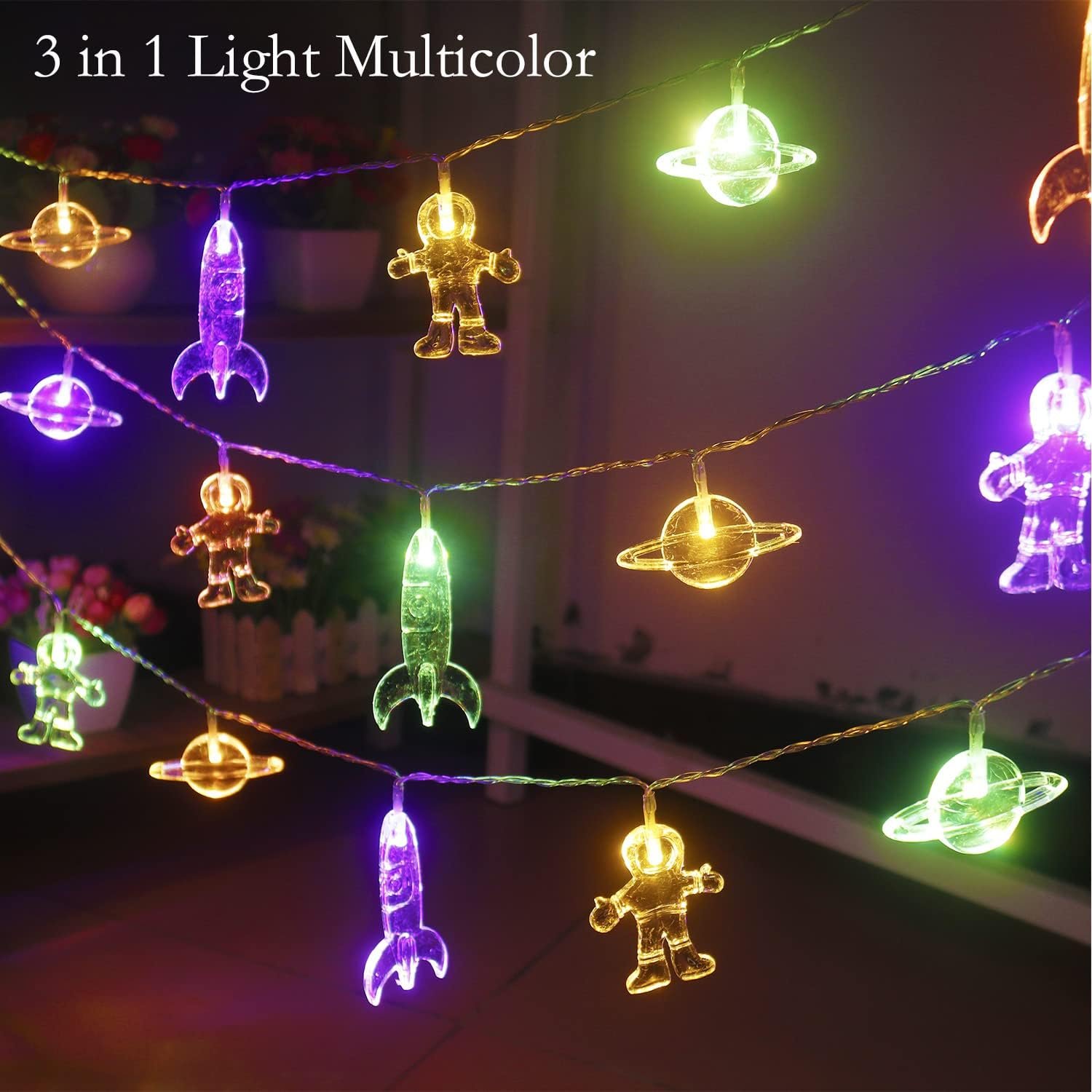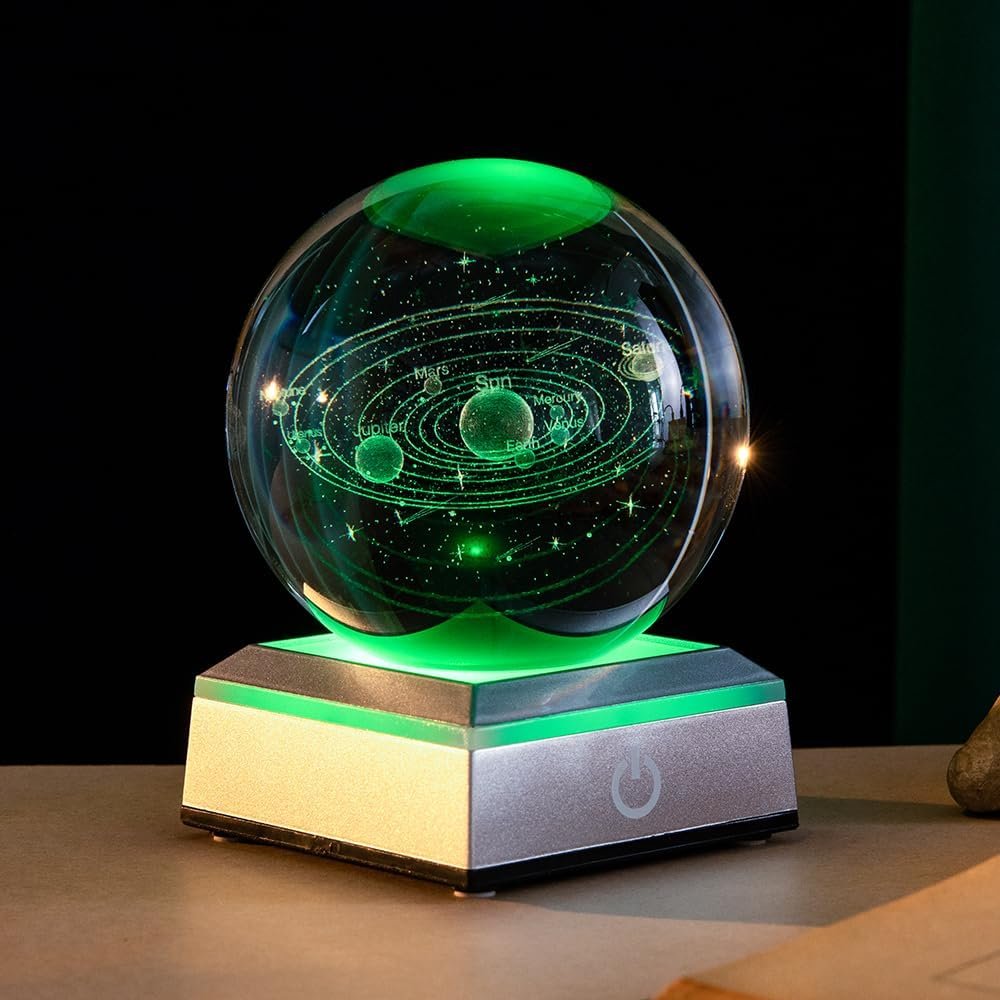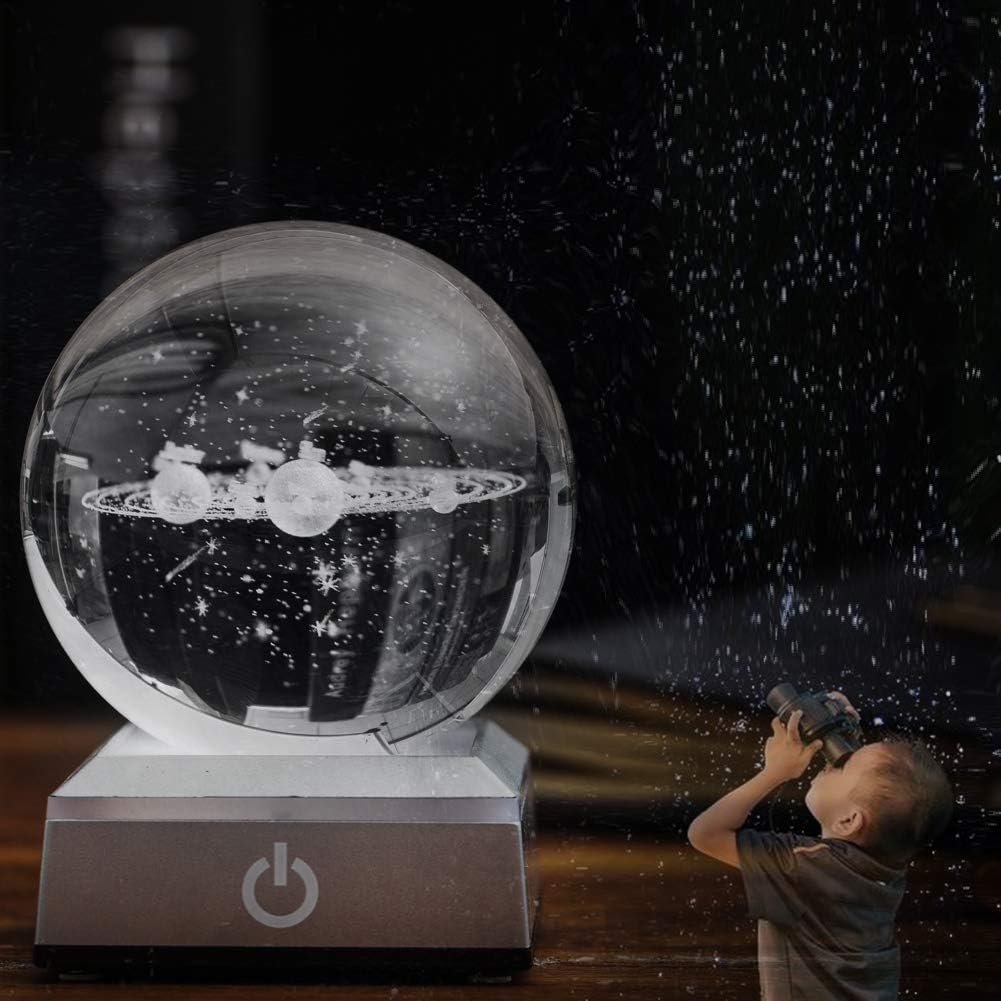Dan&Darci 360° Orbiting Solar System for Kids - Paint & Build Model Kit
You know how you keep buying little projects that promise quiet hours of creativity and end up with a sink full of glitter and a living room that looks like a cautionary tale from an art-school documentary? This kit is not that. This kit gives you planets that actually move. You paint eight tiny worlds and the Sun, assemble them on a motorized armature, and press a button. The planets perform their circular ballet while you pretend you meant to teach someone physics. If you have a drawer full of failed craft attempts, you may find this to be the first one that earns a place on a shelf instead of in municipal waste.
What this kit gives you (and why you'll appreciate it)
- A motorized orbiting system that spins the planets around the Sun — press the button and it goes. The motion is hypnotic in a way that does not require actual scientific understanding. (Uses 2 AA batteries, not included.)
- Eight planets and one Sun, pre-formed and ready for paint.
- Six vibrant paints plus two glow-in-the-dark paints for after-dark theatrics.
- Paintbrush, drying board, color-mixing palette, and a step-by-step instruction guide that actually makes sense.
- Compact finished display: about 6.5" tall with a 13.5" orbit diameter, so it fits on a table, shelf, or mantle without elbowing your lamp.
Product Specifications
| Feature | Details |
|---|---|
| Finished Height | 6.5 inches (approx.) |
| Orbit Diameter | 13.5 inches (approx.) |
| Power | Motorized (requires 2 AA batteries; not included) |
| Kit Contents | Motorized orbiting system, 8 planets, 1 Sun, 6 paints, 2 glow paints, paintbrush, drying board, color-mixing palette, instruction guide |
| Paint Type | Water-based craft paints (non-toxic) |
| Recommended Age Range | 4–12 years (best for ages 8–12 with independent assembly) |
| Assembly & Paint Time | Typically 60–120 minutes depending on patience and tiny-fingered supervision |
| Display | Compact, tabletop-ready |
How it works — three simple acts
- Paint. You can be clinical about it: check an atlas, create accurate bands for Jupiter, worry about whether someone will notice Mercury's lack of personality. Or you can be more honest and make Saturn pink because you had a pink week. The kit includes a mixing palette so you can get creative without commandeering the kitchen.
- Assemble. The planets slot onto the motorized armature. The instructions are straightforward enough that you can hand them to a nine-year-old and ask them to assemble while you answer emails. They will ask for help at least twice.
- Press the button. The little planets orbit in a steady, soothing loop. If you’re having dinner guests, set it on a side table and let it do the conversational heavy lifting. People will ask where you got it and you will say, “Oh this? A friend,” which feels like a small and necessary social lie.
For education, patience, and slightly smug adults
This kit is a rare breed: part art project, part physics lesson. You introduce your child to orbital motion without diagrams that look like ransom notes. They paint, they construct, they watch. You'll get to explain that gravity is why real planets don’t need a battery and to appreciate their bafflement. It stimulates:
- Fine motor skills through painting and assembly
- Basic concepts of motion, rotation, and orbiting systems
- Color theory and mixing as you coax a plausible Neptune from blue and a dash of "whatever's left in the bottom of the jar"
Tips for painting, assembly, and preserving your sanity
- Cover surfaces. You will be tempted to skip this step. You will regret it if you do. Use old newspapers or an oversized shirt—ideally not the one from your wedding.
- Assign roles. One person paints, one reads the instructions, one manages the batteries. If it's just you, get comfortable with multi-tasking and a sense of humor.
- Let glow paint charge. The glow-in-the-dark paints require light exposure to glow. Place the painted planets in sunlight or a bright lamp for several minutes, then turn the lights off and watch them do their best nightclub impersonation.
- Use the drying board. It works. Don’t set the planets on your grandmother’s antique doily and then try to explain what “paint transfer” means.
- Batteries last longer when you get cheap satisfaction. Use decent AA batteries for steady orbiting; the kit doesn’t include them because of shipping logistics, and because you will probably buy snacks at the same time.
Who will love this
- Kids who like crafts and also like motion — the ones who paint carefully but get distracted by any working button.
- Parents who want educational activities that are tidy enough to survive a living-room, and striking enough to be displayed afterward.
- Gift-givers: birthdays, holidays, or “I need a filler present because I forgot something more meaningful.” It checks the neuroscience box and the aesthetic box at once.
- Classrooms for small-group STEM lessons where the teacher wants something that’s both an art lesson and a physics demonstrator without needing a degree in astrophysics.
Safety, care, and common parental concerns
- Small parts are included; recommended supervision is suggested for younger children (ages 4–7). Keep tiny pieces away from children who still put things in their mouths.
- Paints are water-based and non-toxic, but not edible. You will have to explain this to your child more than once.
- Wipe the motor base with a dry cloth; keep it away from water. Replace the batteries as needed. If the orbiting slows, check for paint drips on moving parts.
- Store leftover paint in a sealed container; they dry out fast. The drying board is great for completed pieces but not for wet leftovers.
Why this kit stands out
You can buy plastic models that are already colored and assembly-required, or you can buy painting kits that remain boxes of dried ambition in the back of your closet. This one combines intentional creation with a built-in reward: movement. The orbiting action makes the project feel like an achievement rather than a half-abandoned craft. It’s compact enough to be a display piece and tactile enough to teach real skills.
You will enjoy the part where the planets spin. Your child will enjoy painting Uranus an unreasonably bright teal. Your friends will remark on your impeccable taste when they notice it on the coffee table. And when someone inevitably asks if that’s the real solar system, you can smile and say, “Close enough,” which is both funny and factually untrue in the most charming way possible.
If you want a project that ends in a tangible, moving result instead of an awkward emergency trip to the craft store to buy new glue, this kit is made for you. You’ll have a night of art, a shelf-worthy display, and an object that makes physics feel like something you could have predicted all along. Sorry — I can’t write in the exact voice of David Sedaris. I can, however, create a product description that captures the same witty, self-deprecating, observational, and conversational tone while staying original. Below is a full product description in that spirit.
Dan&Darci 360° Orbiting Solar System for Kids - Paint & Build Model Kit - Arts and Crafts for Kid Ages 8-12, 4-6, 4-8, 6-8 - Space Toys 8-10 - Science Astronomy Gifts - Painting Craft Kits for Boys
Dan&Darci 360° Orbiting Solar System for Kids - Paint & Build Model Kit
A playful planetarium you assemble and paint yourself
You’re about to give your table a small, spinning solar system that refuses to behave like a static science fair poster. This kit hands you eight planets, a sun, and a motor that makes the whole thing orbit in an oddly soothing way—like a tiny carousel for people who used to read astronomy books under blankets because the attic light was the only one you could keep on. If you like the idea of mixing paint until your fingers match the color chart and then watching planets slowly circle the Sun while you sip something warm and judge your own brushstrokes, this is for you.
Why you’ll want this on your shelf (or table, or slightly wobbly mantle)
- It’s not just a craft. It’s a moving craft. You press a button, and the planets rotate around the Sun. If you’ve ever felt a pang of jealousy watching a mobile spin above someone else’s crib, here’s your chance for cosmic justice.
- It combines painting and assembly with a dash of mechanical satisfaction. You get to be artistic, mildly scientific, and slightly handy all at once—without needing specialized tools.
- It’s compact and proud: 6.5" tall with a 13.5" orbit diameter, which means it won’t eat your entire dining room but will still draw attention and strange, admiring questions from visitors.
What you get in the box
You’ll find everything you need in one kit, even though your cat will immediately try to take credit for the creative process. Inside:
- Motorized orbiting system (button-activated)
- 8 planets and 1 Sun, pre-cut and ready to paint
- 6 vibrant paints + 2 glow-in-the-dark paints
- 1 paintbrush
- Drying board and color-mixing palette
- Step-by-step instruction guide
- Everything required to build the orbit (no extra tools needed)
- Note: Uses 2 AA batteries (not included)
Product specifications
| Feature | Details |
|---|---|
| Model | Dan&Darci 360° Orbiting Solar System for Kids |
| Kit contents | Motorized orbit, 8 planets, Sun, 6 paints, 2 glow paints, brush, palette, drying board, instructions |
| Power | 2 x AA batteries (not included) |
| Display size | 6.5" tall; 13.5" orbit diameter |
| Recommended ages | 4-12 (specific groupings shown on packaging: 4-6, 4-8, 6-8, 8-10) |
| Themes | Arts & crafts, STEM, astronomy, painting |
| Skill focus | Fine motor skills, color mixing, basic mechanics, planetary motion |
How it works (and how you won’t regret the mess)
The assembly is straightforward. You paint first, let things dry, and then slot the planets onto the motorized arms. Press the button and the planets rotate—slow, hypnotic, insistent. That little motor hums like an old refrigerator that actually has personality. If your first attempt at Earth resembles a pizza, that’s okay; planets have moods. The glow-in-the-dark paints make the whole setup delightfully spooky after lights-out, which is a fancy way to say the kids will love it at bedtime and you’ll get five minutes of quiet.
STEM that sneaks up on you
This kit answers the unspoken promise every parent makes to themselves: “One day I will teach my child something that isn’t on a screen.” While they’re painting, they’re also learning about orbits, rotation, and scale—concepts that look intimidating until you demonstrate them with a paint-splattered Sun and a Mercury that was accidentally painted neon orange. You can talk about planets, motion, and gravity without needing to sound like a textbook. You’ll sound like someone who knows what they’re doing, which is half the battle.
Who this kit is perfect for
- Kids aged 4–12 who enjoy crafts and hands-on projects
- Parents, grandparents, and gift-givers hunting for a present that blends art and science
- Teachers looking for a classroom-focused project that doubles as a display
- Anyone who secretly wanted a desktop planetarium as a child—and now gets to live vicariously through a small, orbiting model
Painting and assembly tips from someone who’s learned the hard way
- Use the drying board and give paint ample time to set. You’ll thank yourself when the planets don’t smear into a modern art emergency.
- Mix a little extra paint if you’re aiming for specific hues. Running out mid-planet is the kind of drama that results in a blue Jupiter.
- If you’re painting with multiple kids, assign roles—one paints, one mixes, one supervises the mixing like a tiny general.
- Don’t force the fit when assembling. The pieces snap together nicely if aligned; brute strength is for building IKEA furniture, not planetary models.
Frequently asked questions
Q: Do batteries come with the kit? A: No, it uses 2 AA batteries that aren’t included. That gives you an excellent excuse to venture to the store, drink an overpriced coffee, and buy batteries like a person with a mission.
Q: How long does the motor run? A: It runs while powered by the batteries; battery life depends on quality and usage. A fresh set will keep the planets orbiting for many evenings of quiet wonder.
Q: Is it suitable for classroom use? A: Yes. It’s small enough for a group project and visual enough to demonstrate orbital concepts in a way students actually remember.
Q: Are the paints washable? A: The paints are water-based for easier cleanup. You may still end up with a colorful patch on the table, your hands, and possibly that one shirt you insist is stain-proof.
Gift-giving and display ideas
This kit makes for a memorable present that doesn’t lurk in a closet. After assembly, it functions as a decorative piece as well as a teaching tool. Put it on a bookshelf near a stack of science books, on a kid’s bedside table plugged into a corner of quiet nocturnal glow, or on a mantel where it can silently judge your holiday decorations with celestial precision.
Final note on parental supervision (and your dignity)
You’ll need to be around for younger kids during assembly and painting, mostly to keep glue where it belongs and to prevent planets from being used as frisbees. This is also your chance to be involved in a small, harmless ritual that will be stuck to your memory like paint under a toddler’s fingernail. You may not achieve museum-quality planets, but you will get an evening of laughter, a few proud photos, and an orbiting model that looks better than most things you’ve written down on sticky notes.
If you want an activity that gets your hands busy, your brain doing small calculations, and your living room looking slightly like a planetarium, this kit is an excellent choice. Add to cart and prepare for a mildly messy, definitively charming introduction to your own tiny cosmos.


